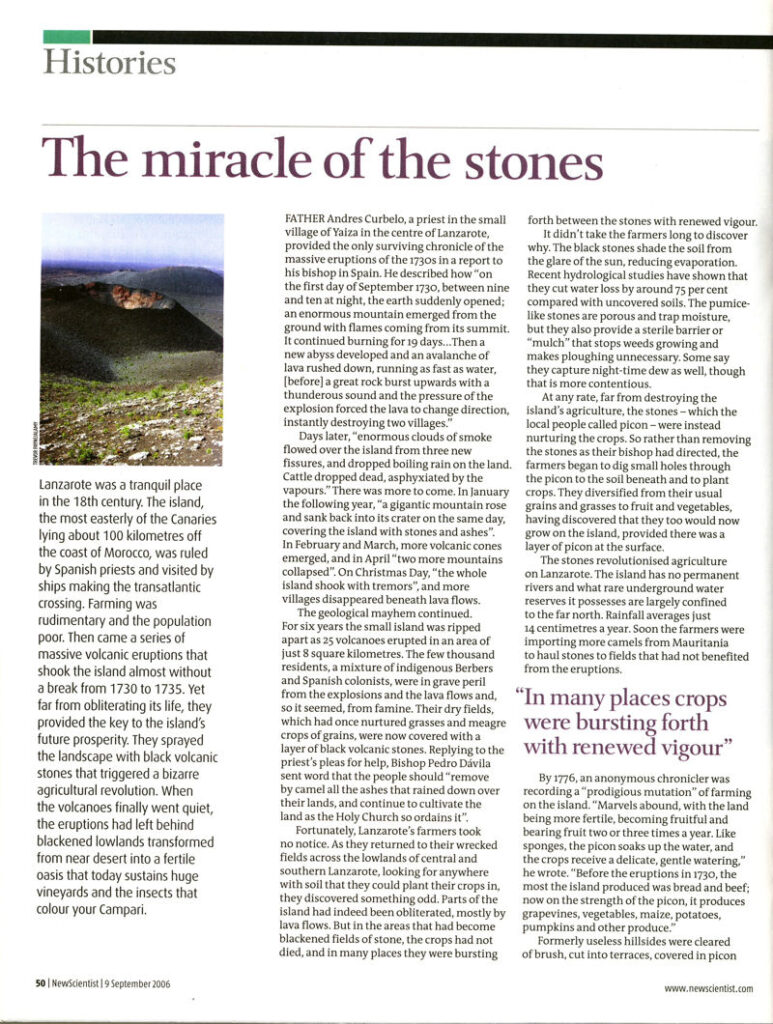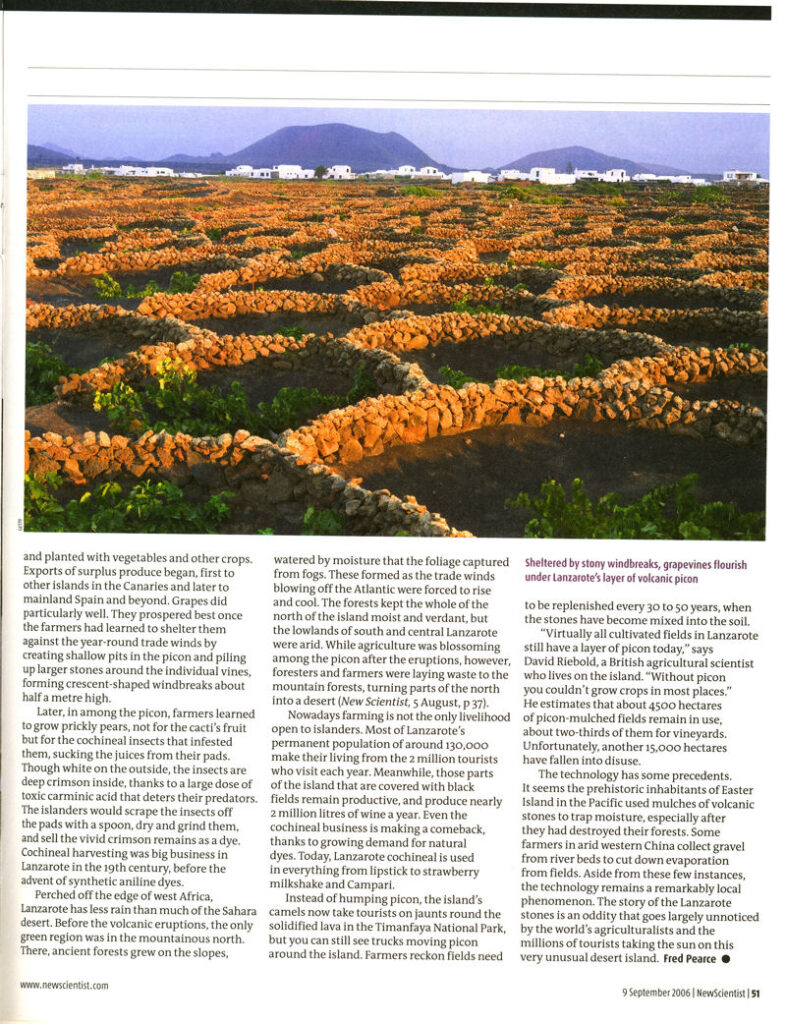One of the many unique features that typify the landscape of Lanzarote is a result of the traditional methods of agriculture developed on a volcanic island with a desert climate. Fields of grey or black gravel, lined with rows of crops, or small semi-circular walls of lava sheltering vines, are an ubiquitous scene when travelling around Lanzarote.
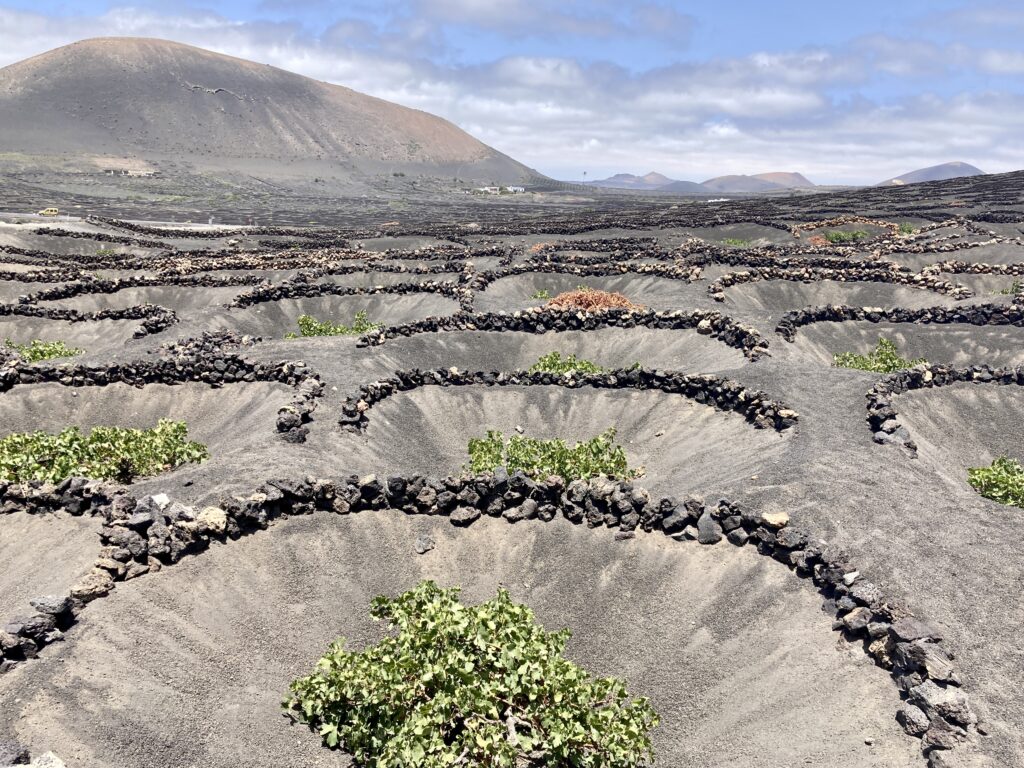
In the following text, published in an article in Clean Slate magazine # 14 (the journal of the Alternative Technology Association), I discuss this traditional dry climate farming technique which may hold water for many arid areas .
What is Mulch?
A mulch in gardening or farming practice is any kind of material laid on the surface of the ground. Conventional agriculture and horticulture have always had a penchant for ‘clean, bare ground’, but this is extremely rare in nature, where soil is nearly always covered by vegetation and/or a layer of decaying plant matter. The various schools of ‘organic’ practice have all emphasised the desirability of keeping the~ soil covered as much as possible.
The type of material used varies according to availability and the specific functions required, The most common reasons for applying mulch are: suppressing temperatures; protecting soil from physical damage by the elements; reducing nutrient loss through leaching; stimulating the activity of soil organism; preparing ground for sowing or planting; and to improve appearance, Nutrient-rich mulches can also serve as slow release fertilisers: The normal response of governments and aid agencies to the problem of limited agricultural water in hot arid zones is to exploit new sources; a dam or borehole feeding a new irrigation scheme. This has frequently resulted in disaster; large dams have triggered earthquakes while boreholes have caused subsidence and contamination of aquifers with sea water.
Diseases such as malaria and schistosomiasis often follows irrigation canals. High evaporation rates (75% is considered normal) cause a fatal build up of salt. Countless acres of once fertile land have been ruined in this way. There are, of course, alternatives to this, which make better use of existing supplies. One such technology, developed over past centuries by the farmers of Lanzarote, deserves to be more widely known.
Despite a climate comparable to the nearby Sahara desert, Lanzarote farmers produce a wide variety of food (fruit, maize, wheat, onions, potatoes, goat fodder etc.) using only a meagre average annual rainfall of 150mm.
This is made possible by the use of stone mulch, a protective soil covering at least 1.0cm deep. Most commonly this consists of lapillis. This is lightweight volcanic gravel known locally as ‘picon’. In one region a layer of coarse sand is exploited with similar results.
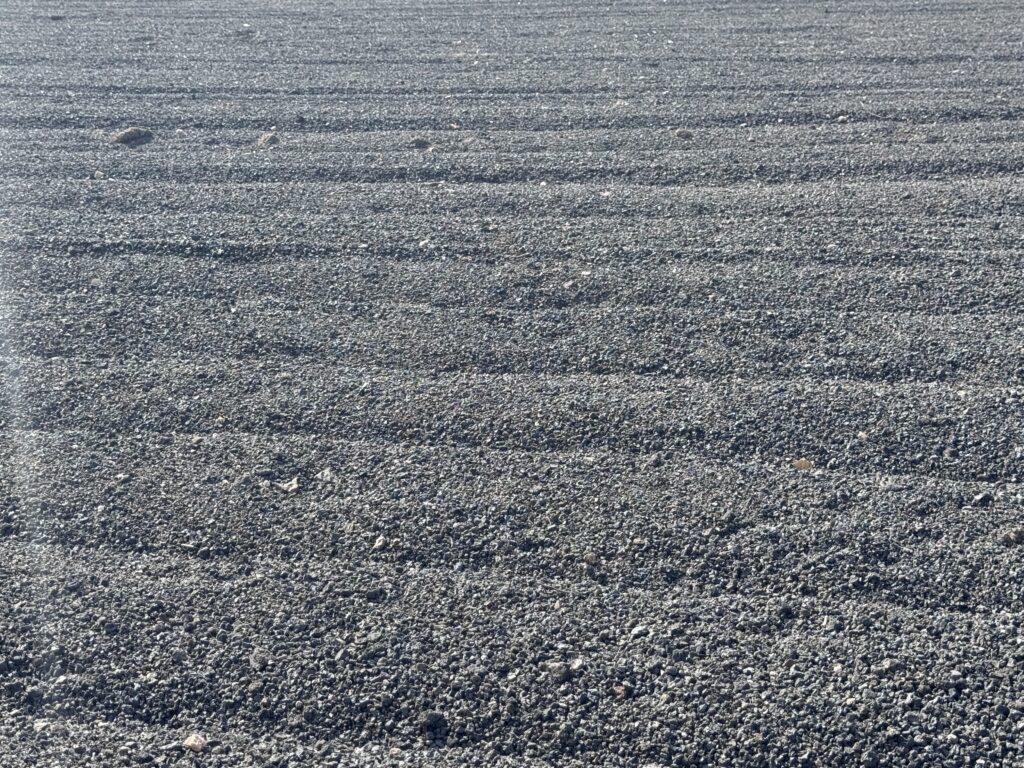
Preventing Evaporation
Canary Island geographies and tourist guides often suggest that picon works by somehow extracting dew from the air and adding it to the soil. This is unlikely, as the theoretical maximum dewfall is far less than the minimum daily evaporation. What I believe to be the true explanation of picon’s remarkable effects is a little more complex (but at least conforms to the laws of thermodynamics). Picon aids infiltration of a heavy rain but afterwards forms a capillary break which almost eliminates subsequent evaporation from the soil. This is so effective that a worthwhile crop can be grown in a prepared (i.e. weeded and levelled) stone mulched field even if the rains fail, using water stored in the soil from the year before.
In Lanzarote’s climate, no other type of mulching material compares in terms of preventing evaporation, high soil temperatures and erosion. Although picon adds no new minerals directly to the soil, it improves soil conditions, preserving soil life and so conserving existing nutrients. Picon also forms a barrier against weed germination. Any weeds that do emerge can be removed by a very light hoeing of the picon; zero till cultivation is possible without herbicides.
A hand plough, or one drawn by a single donkey or camel, is sufficient to make furrows for planting as these only penetrate the mulch layer. In non-irrigated fields, there is no advantage to having a closed crop canopy to shade out weeds, so there is typically wide spacing of individual plants (appropriate to the amount of soil moisture). This in turn enables moist air around the sides of a plant to be constantly replaced; giving side (in addition to top) leaves the opportunity to directly absorb dew and mist, useful but overlooked sources of water.
La importancia que los agricultores locales les dan a estos ha sido confirmada por experimentos en Israel que muestran una mejora del 100% en el rendimiento de los cultivos atribuible a la absorción foliar de rocío.
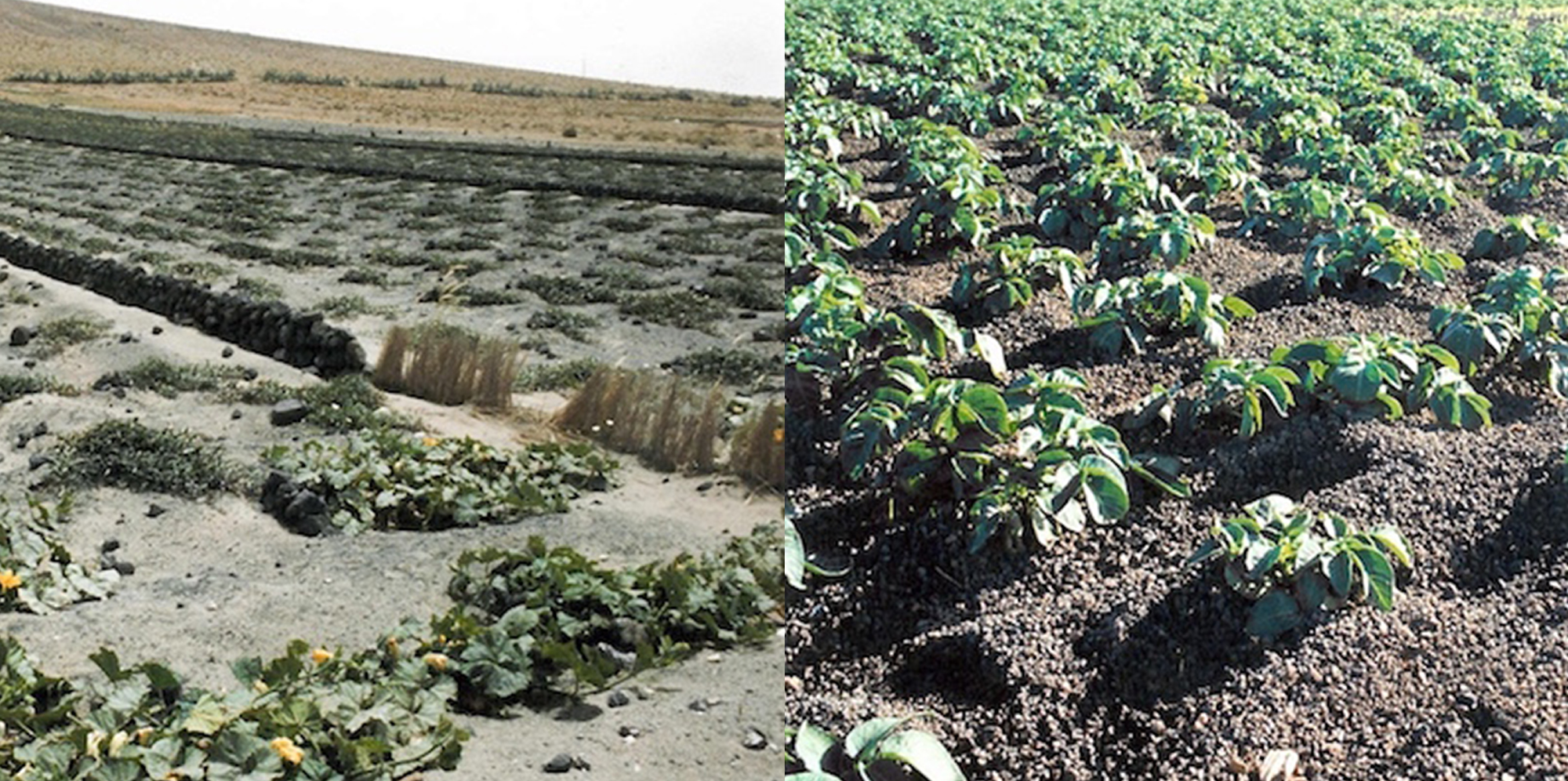
The Wider Potential
En términos de supresión de la evaporación, las técnicas de mantillo de piedra son probablemente las más relevantes para las regiones cálidas donde las precipitaciones son bajas (500 mm al año) y estacionales; picon puede ser una desventaja con lluvia ligera frecuente.
El picón y la piedra pómez, al ser muy livianos, son materiales ideales, pero los suministros están limitados a áreas con vulcanismo reciente. Puede valer la pena probar cualquier otra piedra disponible de un tamaño particular, desde arena gruesa hasta unos 2 cm de diámetro.
Los mantillos de piedra pueden tener un papel en climas más húmedos para la plantación de árboles, la reducción de la temperatura del suelo y la prevención de la erosión, este último beneficio demostrado por la resistencia de los campos de picón con pendientes de más de 20 grados, comunes en Lanzarote a pesar de los fuertes vientos constantes y las feroces tormentas de invierno.
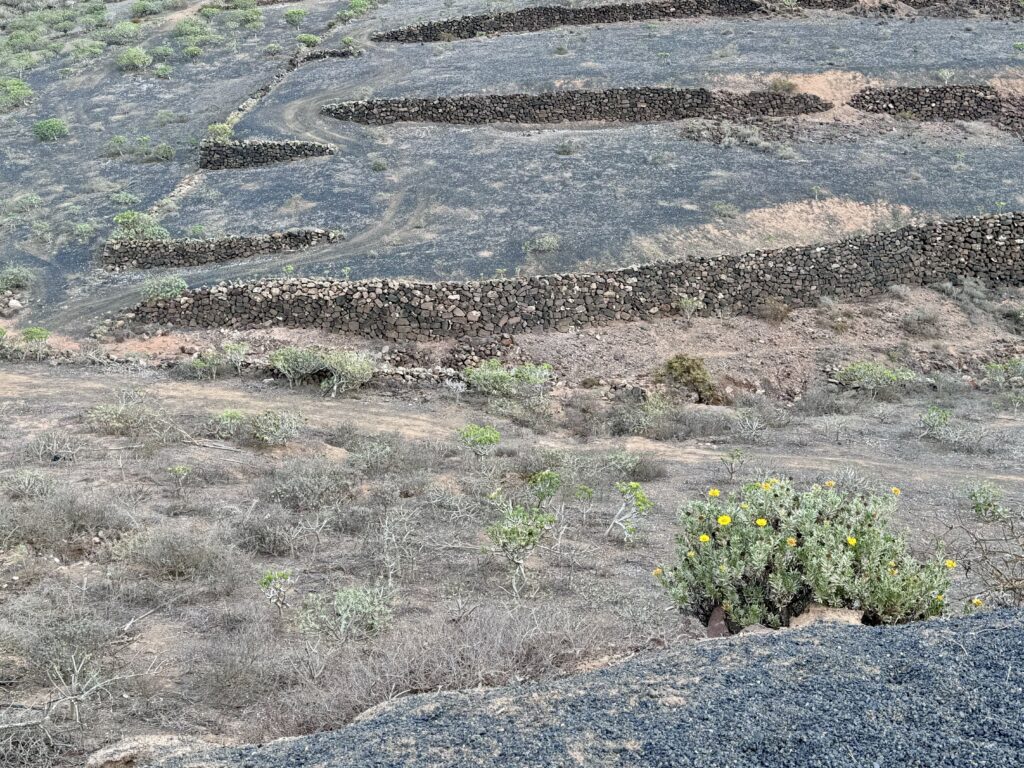
The Future for Lanzarote Farmers
Cheap EU Imports have dealt a body blow to local farming. Unfortunately there is another problem ahead; when used for trees or grapevines picon seems to have an unlimited life, but when harvesting annual crops the picon becomes mixed with the underlying clay. This eventually spoils the capillary break on which the suppression of evaporation depends.
Depending on the type of crop and the amount of care taken, a layer of picon has a useful life of between 20-100 years. At present rates of use, picon supplies will run out m about twenty years. Any ideas for an economical method of renovating old picon would be timely. Both winnowing and washing are effective but obviously not practical on a large scale. Whatever the future of picon cultivation, it’s a good reminder that alternatives to environmentally disastrous irrigation schemes are not only possible but may already be perfected by Ignored ‘peasants’. The world’s water crisis IS urgent.
No podemos seguir ignorando esta riqueza de conocimientos técnicos indígenas. He acumulado una pequeña y triste pila de artículos científicos que representan muchos años de investigación sobre mantillos y evaporación, casi todos los cuales simplemente duplican la información conocida en Lanzarote durante siglos.
Varias otras soluciones locales fascinantes para la escasez de agua se describen en una serie de artículos en New Scientist por Fred Pearce (25 de marzo, 1 de junio, 7 de diciembre de 1991); Tomando prestada la conclusión de ese autor: en hidrología es posible que tengamos que mirar hacia atrás para progresar.
I wrote the letter below, which was published in New Scientist, 14 May 2005, p. 29:
Cosecha de niebla
Los agricultores aquí en Lanzarote valoran el rocío, pero no están de acuerdo en que el mantillo de piedra que usan funciona alimentando el rocío directamente a las raíces de los cultivos (16 de abril, p. 52). Un examen rápido confirma que incluso el rocío más denso solo humedece la superficie del mantillo y que se evapora rápidamente durante el día.
La deposición de rocío (a diferencia de la niebla o la neblina) sobre una superficie está muy limitada por la necesidad de que la superficie pierda el calor obtenido a medida que el agua se condensa, normalmente por radiación en un cielo despejado. Las plantas, especialmente en condiciones de sequía, pueden absorber agua directamente a través de sus hojas, pero las cantidades disponibles tienen una importancia limitada para un cultivo con un dosel cerrado. Sin embargo, un mantillo de piedras puede ser tan efectivo para prevenir el crecimiento de malezas que se vuelve práctico espaciar ampliamente las plantas de cultivo. Esto no solo es apropiado para las condiciones de lluvia de Lanzarote (igual que el cercano Sahara), sino que también permite que otras partes de la planta absorban el rocío directamente a través de las hojas, mejorando notablemente el crecimiento.
The following article featured in New Scientist elaborates on the history of agriculture in Lanzarote, by Fred Pearce.
